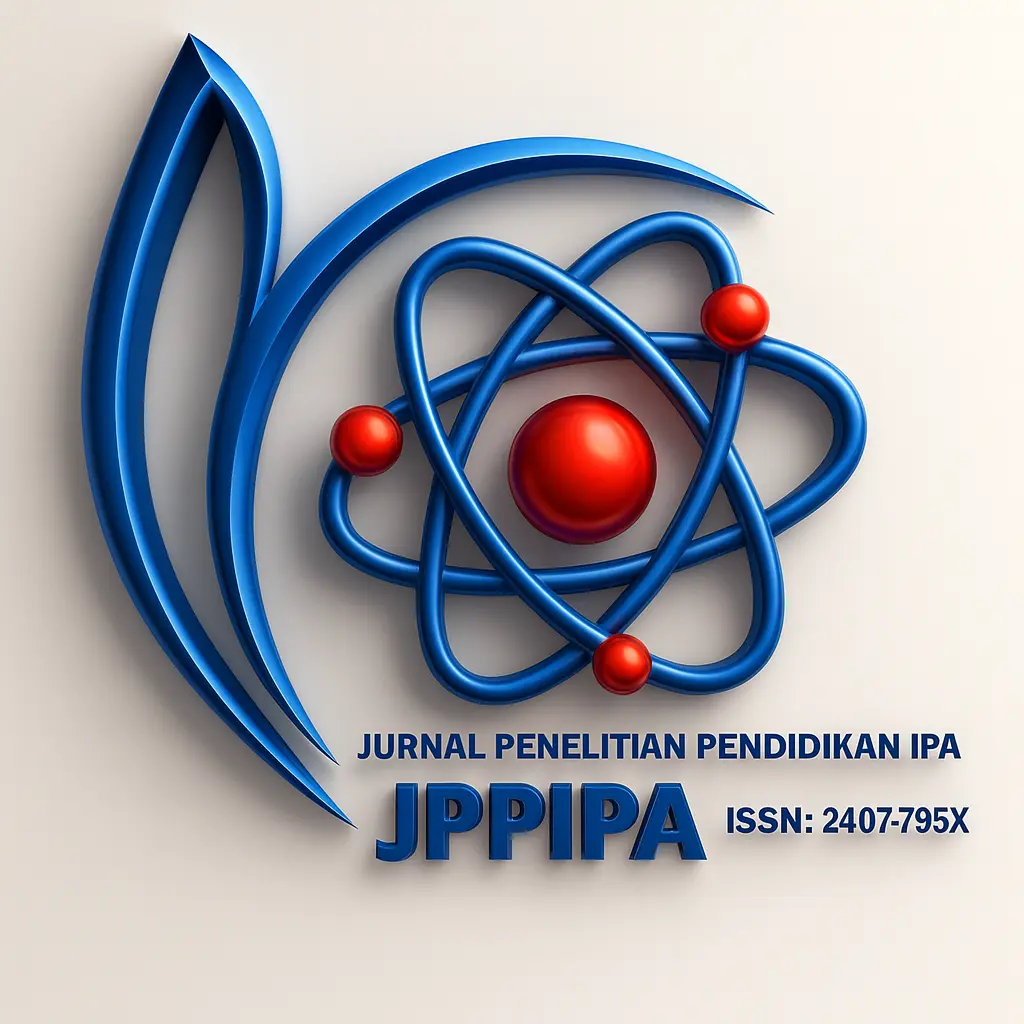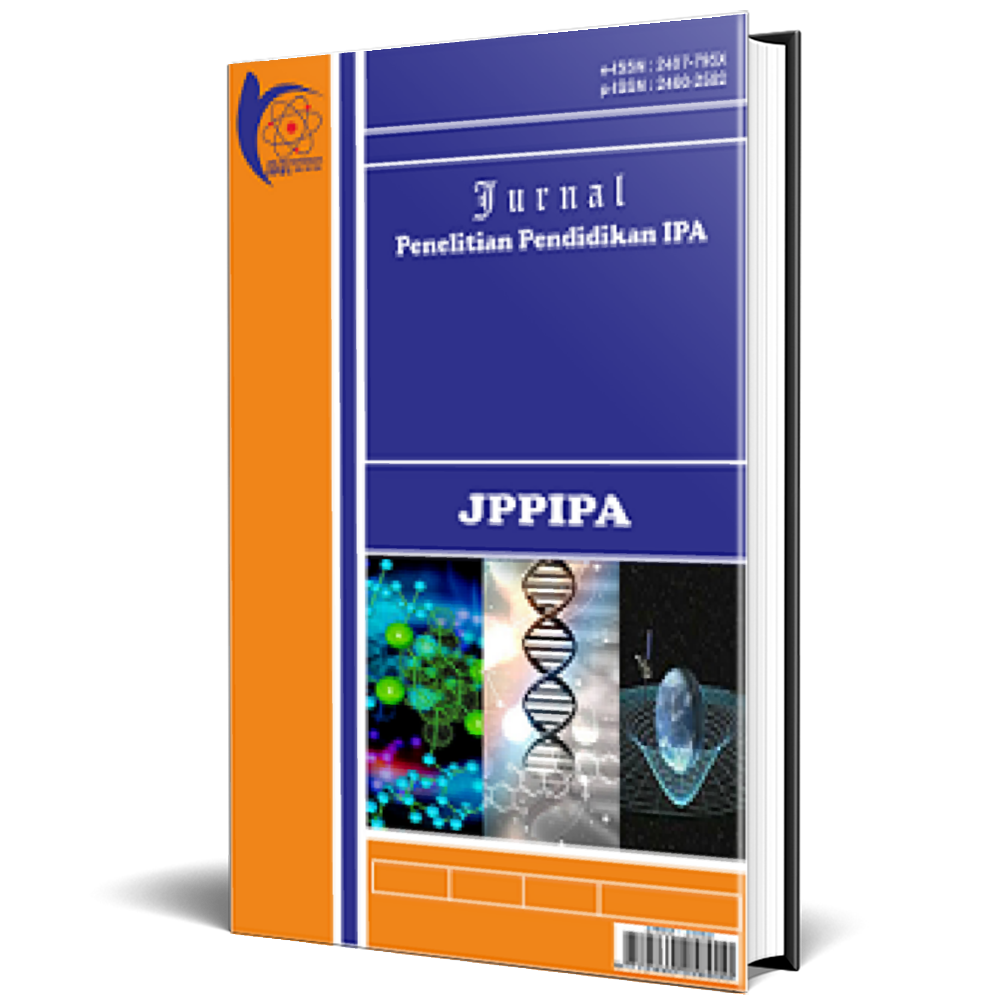Science Literacy Profile of Junior High School Students on Climate Change Material
DOI:
10.29303/jppipa.v9i11.5208Published:
2023-11-25Downloads
Abstract
This research aims to describe the profile of scientific literacy abilities in science subjects with material on climate change for class VIII students at SMPN 3 Cileungsi. The research was conducted using the ex-post-facto method on 76 respondents. Data collection was carried out using an interview guide sheet and a scientific literacy test which consisted of competency aspects in explaining scientific phenomena, evaluating and designing scientific investigations, and interpreting scientific evidence and data. The scientific literacy data was then analyzed using quantitative descriptive tests. Based on the results obtained, the average scientific literacy score was 31.58% in the low category. The highest level of knowledge was in the low category in 47 respondents with a score of 61.8%, while the highest score was in the 29 respondents with a score of 38.2% in the medium category. The low scientific literacy abilities of students are influenced by several factors such as learning resources that lack scientific literacy coverage, evaluation questions that do not refer to scientific literacy indicators, and digital teaching materials that are able to increase scientific literacy. Based on the data obtained, it can be concluded that students' scientific literacy in climate change material is still relatively low.
Keywords:
Climate change, Junior high school, Scientific literacyReferences
Angraini, G. (2014). Analisis Kemampuan Literasi Sains Siswa Sma Kelas X Di Kota Solok. Prosiding Mathematics and Sciences Forum 2014, 161–170. Retrieved from https://prosiding.upgris.ac.id/index.php/masif2014/masif2014/paper/viewFile/427/378
Anisa, A. R., Ipungkarti, A. A., & Saffanah, K. N. (2021). Pengaruh Kurangnya Literasi Serta yang Masih Rendah dalam Pendidikan di Indonesia. In Current Research in Education: Conference Series Journal, 1. htt Retrieved from ps://ejournal.upi.edu/index.php/crecs/article/view/32685/pdf
Ardianto, D., & Rubini, B. (2016). Comparison of students’ scientific literacy in integrated science learning through model of guided discovery and problem-based learning. Jurnal Pendidikan IPA Indonesia, 5(1), 31–37. https://doi.org/10.15294/jpii.v5i1.5786
Astuti, Y. K. (2016). Literasi Sains dalam Pembelajaran IPA. Jurnal Pendidikan, 7(3b), 67–71. Retrieved from https://docplayer.info/34125466-Literasi-sains-dalam-pembelajaran-ipa-oleh-yani-kusuma-astuti-stkip-nu-indramayu-jawa-barat.html
Ayu, N. P. A., Suryanda, A., & Dewi Pendidikan Biologi, R. W. (2018). Relationship of Reading Habits with The Ability of Scientific Literacy in High School Student in East Jakarta. Jurnal Ilmiah Biolodi, 7(2).
Azrai, E. P., Suryanda, A., Wulaningsih, R. D., & Sumiyati, U. K. (2020). Kemampuan Berpikir Kritis dan Literasi Sains Siswa SMA di Jakarta Timur. EDUSAINS, 12(1), 89–97. https://doi.org/10.15408/es.v12i1.13671
Gormally, C., Brickman, P., & Lutz, M. (2012). Developing a Test of Scientific Literacy Skills (TOSLS): Measuring Undergraduates’ Evaluation of Scientific Information and Arguments. CBE—Life Sciences Education, 11(4), 364–377. https://doi.org/10.1187/cbe.12-03-0026
Haqiqi, L. Z., Ramdani, A., & Zulkifli, L. (2018). Analisis Kemampuan Pendidik dalam Menerapkan Penilaian Autentik pada Mata Pelajaran Biologi Kelas X IPA SMA di Kabupaten Lombok Timur. Jurnal Penelitian Pendidikan IPA, 4(1). https://doi.org/10.29303/jppipa.v4i1.60
Holbrook, J., & Rannikmae, M. (2009). The Meaning of Science Literacy. International Journal of Environmental & Science Education, 4(3), 275–288. Retrieved from https://files.eric.ed.gov/fulltext/EJ884397.pdf
Huryah, F., Sumarmin, R., & Effendi, J. (2017). Analisis Capaian Literasi Sains Biologi Siswa Sma Kelas X Sekota Padang. Jurnal Eksakta Pendidikan (Jep), 1(2), 72. https://doi.org/10.24036/jep.v1i2.70
Kartika, I., Kurniasih, S., & Pursitasari, I. D. (2019). Pengembangan Bahan Ajar Berbasis Socio-Scientific Issues Pada Materi Bioteknologi Untuk Meningkatkan Literasi Sains Siswa. Journal of Science Education and Practice, 3(1), 1–12. https://doi.org/10.33751/jsep.v3i1.1375
Komalasari, B. S., Jufri, A. W., & Santoso, D. (2019). Pengembangan Bahan Ajar IPA Berbasis Inkuiri Terbimbing untuk Meningkatkan Literasi Sains. Jurnal Penelitian Pendidikan IPA, 5(2), 219–227. https://doi.org/10.29303/jppipa.v5i2.279
Makhrus, M., Harjono, A., Syukur, A., Bahri, S., & Muntari, M. (2018). Analisis Rencana Pelaksanaan Pembelajaran (RPP) Terhadap Kesiapan Guru Sebagai “Role Model†Keterampilan Abad 21 Pada Pembelajaran IPA SMP. Jurnal Penelitian Pendidikan IPA, 5(1). https://doi.org/10.29303/jppipa.v5i1.171
Mardhiyyah, L. A., Rusilowati, A., & Linuwih, S. (2016). Pengembangan Instrumen Asesmen Literasi Sains Tema Energi. Journal of Primary Education, 5(2). https://doi.org/10.15294/jpe.v5i2.12905
OECD. (2001). PISA 2000 Result in Focus: What 15-year- olds know and what they can do with what they know. OECD Publishing.
OECD. (2004). PISA 2003 Result in Focus: What 15-year-olds know and what they can do with what they know. OECD Publishing.
OECD. (2007). Science Competencies for Tomorrow’s World. OECD Publishing.
OECD. (2010). Assesing framework key competencies in reading, mathematics, and science. OECD Publishing.
OECD. (2013). Assessment and Analytical Framework: Mathematics, Reading, Science, Problem Solving and Financial Literacy. OECD Publishing.
OECD. (2016). PISA 2015 Results (Volume I): Excellence and Equity in Education. OECD Publishing.
OECD. (2019). PISA 2018 Insights and Interpretations. OECD Publishing.
Pantiwati, Y., & Husamah. (2016). Analisis Literasi Sains Siswa SMP Kota Malang. Prosiding Konferensi Ilmiah Tahunan, 48–64. Retrieved from https://rb.gy/szz94k
Permadi, A. S., Purtina, A., & Jailani, M. (2020). The Effect of Information Technology Utilization and Communication on Study Motivation. Jurnal Pendidikan Guru Pendidikan Dasar, 6(1), 16–21. Retrieved from http://journal.umpalangkaraya.ac.id/index.php/
Pratiwi, S. N., Cari, C., & Aminah, N. S. (2019). Pembelajaran IPA Abad 21 Dengan Literasi Sains Siswa. Jurnal Materi Dan Pembelajaran Fisika, 9(1), 34–42. Retrieved from https://jurnal.uns.ac.id/jmpf/article/view/31612
Rizkita, L., Suwono, H., & Susilo, H. (2016). The Analysis Of Initial Ability Of Student’s Scientific Literacy In High School In Malang. Prosiding Seminar Nasional II Tahun 2016, Maret(1), 771–781. Retrieved from http://research-report.umm.ac.id/index.php/research-report/article/viewFile/657/865
Robertson, S. L. (2021). Provincializing the OECD-PISA global competences project. Globalisation, Societies and Education, 19(2), 167–182. https://doi.org/10.1080/14767724.2021.1887725
Rohana, R., Asrial, A., & Zurweni, Z. (2020). Profil Kemampuan Literasi Sains Peserta Didik Berdasarkan Instrumen Scientific Literacy Assessments (SLA). BIOEDUSAINS:Jurnal Pendidikan Biologi Dan Sains, 3(2), 176–185. https://doi.org/10.31539/bioedusains.v3i2.1848
Sujudi, M. S., Idris, T., S, S., & Handayani, P. H. (2020). Profil Kemampuan Literasi Sains Siswa SMP Islam As-Shofa Kota Pekanbaru Berdasarkan PISA. Journal of Natural Science and Integration, 3(1), 58. https://doi.org/10.24014/jnsi.v3i1.9023
Sumandya, I. W., Suarni, N. M., Mahendra, I. W. E., & Panglipur, I. R. (2020). Developing assessment of vocation-based hots on mathematics subject for x class of vocational school. International Journal of Scientific and Technology Research, 9(2), 2900–2903. Retrieved from https://www.ijstr.org/final-print/feb2020/Developing-Assessment-Of-Vocation-based-Hots-On-Mathematics-Subject-For-X-Class-Of-Vocational-School.pdf
Supriadi, S., Wildan, W., & Laksmiwati, D. (2020). Implementasi Model Pembelajaran Berbasis Masalah dan Pengaruhnya terhadap Perkembangan Karakter Mahasiswa. Jurnal Penelitian Pendidikan IPA, 6(1), 63–68. https://doi.org/10.29303/jppipa.v6i1.323
Wahyu, Y., Suastra, I. W., Sadia, I. W., & Suarni, N. K. (2020). The Effectiveness of Mobile Augmented Reality Assisted STEM-Based Learning on Scientific Literacy and Students’ Achievement. International Journal of Instruction, 13(3), 343–356. https://doi.org/10.29333/iji.2020.13324a
World Economic Forum. (2015). New Vision for Education: Unlocking the Potential of Technology. New Vision for Education: Unlocking the Potencial of Technology.
Yusnia, Y. (2019). Penggunaan Media Video Scribe Dalam Pembelajaran Literasi Sains Untuk Mahasiswa Pgpaud. Cakrawala Dini: Jurnal Pendidikan Anak Usia Dini, 10(1), 71–75. https://doi.org/10.17509/cd.v10i1.17436
Zawawi, T. Z., Mustapha, R., & Habib, A. R. (2005). Pedagogical Content Knowledge of Mathematic Teachers on Fraction: A Case at Primary Schools. Jurnal Pendidikan Malaysia, 34(1), 131–153.
License
Copyright (c) 2023 Triska Nuryanti, Indarini Dwi Pursitasari, Bibin Rubini

This work is licensed under a Creative Commons Attribution 4.0 International License.
Authors who publish with Jurnal Penelitian Pendidikan IPA, agree to the following terms:
- Authors retain copyright and grant the journal right of first publication with the work simultaneously licensed under a Creative Commons Attribution 4.0 International License (CC-BY License). This license allows authors to use all articles, data sets, graphics, and appendices in data mining applications, search engines, web sites, blogs, and other platforms by providing an appropriate reference. The journal allows the author(s) to hold the copyright without restrictions and will retain publishing rights without restrictions.
- Authors are able to enter into separate, additional contractual arrangements for the non-exclusive distribution of the journal's published version of the work (e.g., post it to an institutional repository or publish it in a book), with an acknowledgment of its initial publication in Jurnal Penelitian Pendidikan IPA.
- Authors are permitted and encouraged to post their work online (e.g., in institutional repositories or on their website) prior to and during the submission process, as it can lead to productive exchanges, as well as earlier and greater citation of published work (See The Effect of Open Access).









